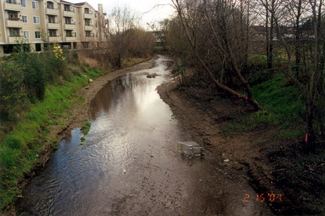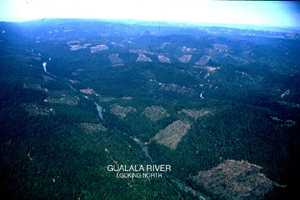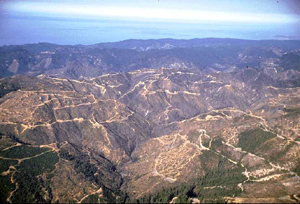Bibliography Background About KRIS
Cumulative Watershed Effects
 Cumulative effects are "those effects on the environment that result from the incremental effect of the action when added to past, present and reasonably foreseeable future actions regardless of what agency (federal or nonfederal) or person undertakes such other actions. Cumulative effects can result from individually minor but collectively significant actions taking place over a period of time" (FEMAT, 1993). Data from May et al. (1994) and Friedrichsen (1998) suggests the greatest threat to watersheds cumulatively may be from urbanization. Agricultural activities may also contribute to cumulative effects in some northwestern California streams, such as the Shasta and Scott rivers, in the portion of the Klamath Basin still accessible to anadromous fish (Kier Associates, 1999). For more on cumulative effects related to development, see the Urbanization KRIS Background page.
Cumulative effects are "those effects on the environment that result from the incremental effect of the action when added to past, present and reasonably foreseeable future actions regardless of what agency (federal or nonfederal) or person undertakes such other actions. Cumulative effects can result from individually minor but collectively significant actions taking place over a period of time" (FEMAT, 1993). Data from May et al. (1994) and Friedrichsen (1998) suggests the greatest threat to watersheds cumulatively may be from urbanization. Agricultural activities may also contribute to cumulative effects in some northwestern California streams, such as the Shasta and Scott rivers, in the portion of the Klamath Basin still accessible to anadromous fish (Kier Associates, 1999). For more on cumulative effects related to development, see the Urbanization KRIS Background page.
 Reeves et al. (1993) found that Oregon coastal river basins where timber harvest exceeded 25% disturbance supported only one salmonid species while river basins under that threshold level maintained diverse assemblages. Ligon et al. (1999) found that California Forest Practice Rules were not preventing cumulative watershed effects and further damage to Pacific salmon stocks. Dunne et al. (2000) proposed "that responsibility for the assessments be taken out of Timber Harvest Applications and given to a new unit of a State agency, which would make whole-watershed assessments of how land use alters the risk of damage to ecosystem values." KRIS provides access to data from many disciplines which can improve assessment of logging-related cumulative watershed effects, as recommended by Dunne et al. (2000). See this 2002 photo of the convergence of the South Fork Gualala and the Wheatfield Fork Gualala River to see cumulative effects results to stream.
Reeves et al. (1993) found that Oregon coastal river basins where timber harvest exceeded 25% disturbance supported only one salmonid species while river basins under that threshold level maintained diverse assemblages. Ligon et al. (1999) found that California Forest Practice Rules were not preventing cumulative watershed effects and further damage to Pacific salmon stocks. Dunne et al. (2000) proposed "that responsibility for the assessments be taken out of Timber Harvest Applications and given to a new unit of a State agency, which would make whole-watershed assessments of how land use alters the risk of damage to ecosystem values." KRIS provides access to data from many disciplines which can improve assessment of logging-related cumulative watershed effects, as recommended by Dunne et al. (2000). See this 2002 photo of the convergence of the South Fork Gualala and the Wheatfield Fork Gualala River to see cumulative effects results to stream.
 Coats and Miller (1981) noted that lower Klamath River basin tributaries suffered substantial sediment impacts when timber harvest took place in more than 30% of the watershed area. Pictured at left is the Terwer Creek watershed. This watershed was in U.S. Forest Service ownership but was swapped to a private industrial forestry as part of the Redwood National Park acquisition in 1972. In addition to widespread clear cut logging, the second growth plantations and brush fields in the upper watershed caught fire in 1988. Subsequent salvage logging took both old and young trees. This watershed is immediately next to the coast with fog often intruding during summer, yet regeneration of forests is not progressing rapidly. See a photo of lower Terwer Creek to see cumulative effects result to stream.
Coats and Miller (1981) noted that lower Klamath River basin tributaries suffered substantial sediment impacts when timber harvest took place in more than 30% of the watershed area. Pictured at left is the Terwer Creek watershed. This watershed was in U.S. Forest Service ownership but was swapped to a private industrial forestry as part of the Redwood National Park acquisition in 1972. In addition to widespread clear cut logging, the second growth plantations and brush fields in the upper watershed caught fire in 1988. Subsequent salvage logging took both old and young trees. This watershed is immediately next to the coast with fog often intruding during summer, yet regeneration of forests is not progressing rapidly. See a photo of lower Terwer Creek to see cumulative effects result to stream.
 Roads are one of the major contributors of sediment to northern California streams and a major problem with regard to cumulative watershed effects (see Roads Background page). The image at left shows the Stewart Creek Calwater in the North Fork Gualala River watershed, which had 7.08 miles pf road per square mile (mi./sq. mi.) of watershed area, but not including temporary roads and landings, which are visible at left. Main haul roads mapped by U.C. Davis ICE project. The National Marine Fisheries Service (1996) recommends no more than 2 mi./sq. mi., with few or no stream side roads to achieve "properly functioning watershed condition." Higgins (2002) postulated that rapid recovery of Freshwater Creek from earlier logging in Freshwater Creek (Humboldt County) was that there were no roads associated with operations.
Roads are one of the major contributors of sediment to northern California streams and a major problem with regard to cumulative watershed effects (see Roads Background page). The image at left shows the Stewart Creek Calwater in the North Fork Gualala River watershed, which had 7.08 miles pf road per square mile (mi./sq. mi.) of watershed area, but not including temporary roads and landings, which are visible at left. Main haul roads mapped by U.C. Davis ICE project. The National Marine Fisheries Service (1996) recommends no more than 2 mi./sq. mi., with few or no stream side roads to achieve "properly functioning watershed condition." Higgins (2002) postulated that rapid recovery of Freshwater Creek from earlier logging in Freshwater Creek (Humboldt County) was that there were no roads associated with operations.
Eggs and Alevin
Salmon and trout are very susceptible to sediment pollution because they build their nests in stream bottoms (Chapman, 1988). Fine sediment less than 0.85 mm can intrude into redds and smother eggs while sand-sized particles (<6.4 mm) tend to cap redds and prevent fry emergence. Logging has the potential to substantially elevate both coarse and fine sediment contributions to a stream. The ability of salmon to reduce fine sediment inside their nests is well recognized (Chapman, 1988). Large concentrations of adult salmon may actually help to alleviate high levels of fine sediment locally in the streambed through spawning activity. If the salmon population drops, this synergistic benefit is lost. Although a redd may have low fine sediment concentrations immediately after completion, silt and sand may intrude into the streambed in subsequent storms and reduce egg and alevin survival (Kondolf, 2000).
Eggs take 30 days or longer to hatch and alevins then remain in the nest for another 30 days after hatching. If sediment transport occurs during the 60 day period when eggs and alevin are in the gravel, they may be washed out, smothered or entombed. Sediment contributions related to logging may decrease average particle size of the stream bed (Knopp, 1993), which can increase bedload mobility which also threaten egg and alevin survival (Nawa et al., 1990). Large wood helps to trap and stabilize spawning gravels and removal of large wood from channels as part of logging or stream clearance projects can contribute to gravel mobility. Increased peak flows due to altered hydrology related to logging (Ziemer, 1998) can increase the effects of storm events that mobilize bedload and reduce survival of salmonid eggs and alevin. Matrix: Potential Cumulative Watershed Effects (CWE) for Eggs/Alevin
Juvenile Salmonids
Steelhead and coho salmon juveniles must spend at least one year in fresh water if they are to survive their transition to life in the ocean. Increased sediment production leads to elevated suspended sediment or turbidity which, according to Newcombe and MacDonald (1991), may directly kill fish or negatively impact survival and growth, modify natural movements and migrations of fish, and reduce abundance of food organisms available to fish. Reduced size of juvenile salmonids related to chronic turbidity or decreased food availability may then reduce ocean survival.
High sediment yield also fills pools, which are essential rearing habitat for coho salmon and yearling and older steelhead juveniles. Inordinately high flood peaks related to cumulative effects from logging may make it difficult for young salmonids to maintain position and to survive through winter. The latter problem may be exacerbated by the lack of large wood in streams that might otherwise provide cover and shelter during high flows (Stillwater Sciences, 1997). Chen (1992) modeled impacts from timber harvest for the Elk River Basin in Oregon. He suggested that pool depth was the best indicator of a stream's ability to support older-age steelhead, and he linked land use to that particular variable. Brown et al. (1994) noted that preferred coho habitat for juvenile rearing was pools over a meter in depth.
Sediment yield may contribute to stream widening if riparian zones are damaged by sediment transport. This coupled with timber harvest in riparian zones can change the ambient air temperature over streams, making them subject to warming (Pool and Berman, 2000). Reduced pool depth also contributes to an increased width-to-depth ratios, facilitating heat exchange. Thus, cumulative effects play a significant role in the elevation of stream temperatures, which can be a major limiting factor for survival of salmonid juveniles.
Site preparation after clear cuts may involve use of herbicides which, if inappropriately applied, can introduce toxins to streams. Herbicides can have direct and indirect effects on juvenile salmonid growth and might also impact aquatic invertebrate communities upon which salmonids rely for food. Folmar (1976) showed that rainbow trout avoided herbicides even at low concentrations. Point and non-point source toxic pollution from agricultural or residential pesticide use also has the potential to negatively effect juvenile salmonids. Matrix: CWE for Juvenile Salmonids
Adult Salmon and Steelhead
Adult salmonids are less effected by impacts of sediment and other factors related to cumulative watershed effects. During low flow conditions in fall, adult coho salmon may find it difficult to survive until spawning time because of lack of pool depth. Stress related to lack of depth and cover may reduce fecundity and success of spawning. High turbidity may also contribute to adult stress and decreased spawning success. Adult fish passage may also be hampered by improperly placed or sized culverts. Matrix: Potential CWE Adult Salmon and Steelhead
Domestic Water Supplies
There are many ways that timber harvesting activities may interfere with the availability or quality of domestic water supplies. Elevated turbidity may exceed drinking water standards (<25 ntu), requiring additional treatment. High bedload transport may overwhelm intake structures. Vehicles associated with logging and herbicides may pose the risk of directly contributing toxins to water supplies. Agricultural activities and septic tanks on rural homesteads can also pollute drinking water. Matrix: Potential CWE for Domestic Water Supplies
References
Brown, L.R., P.B. Moyle, and R.M. Yoshiyama. 1994. Historical Decline and Current Status of Coho Salmon in California. North American Journal of Fisheries Management. 14(2):237-261.
Cedarholm, C.J., L.M. Reid and E.O. Salo. 1981. Cumulative watershed effects of logging road sediment on salmonid populations in the Clearwater River, Jefferson, Co., Washington. In: Proceedings from Salmon Spawning Gravel: A Renewable Resource in the Pacific Northwest? P. 38-74. State of Washington Research Center, Pullman, WA.
Chen, G. K. 1992. Use of basin survey data in habitat modeling and cumulative watershed effects analyses. As FHR Currents # 8. US Forest Service, Region 5. Eureka, CA. 11 pp. [202kb]**
Chapman, D.W. 1988. Critical review of variables used to define effects of fines in redds of large salmonids. Trans. Am. Fish. Soc. 117: 1-21.
Coats, R.N. and T.O. Miller. 1981. Cumulative Silvicultural Impacts on Watersheds: A Hydrologic and Regulatory Dilemma. Environmental Management. Volume 5, No. 2, pp. 147-160.
Dunne, T., J. Agee, S. Beissinger, W. Dietrich, D. Gray, M. Power, V. Resh, and K. Rodrigues. 2001. A scientific basis for the prediction of cumulative watershed effects. The University of California Committee on Cumulative Watershed Effects. University of California Wildland Resource Center Report No. 46. June 2001. 107 pp. [555k]
FEMAT. 1993. Forest Ecosystem Management Assessment Team Report. Sponsored by USDA Forest Service, US Environmental Protection Agency, USDOI Bureau of Land Management, National Park Service. Portland, Oregon.
Friedrichsen, G. 1998. Eel River water quality monitoring project. Final report. Submitted to State Water Quality Control Board, for 205(J) Contract #5-029-250-2. Humboldt County Resources Conservation District. Eureka, CA. 76 pp. [924kb]**
Folmar, L. 1976. Overt avoidance reaction of nine herbicides by rainbow trout. Environmental Contamination and Toxicology Journal. 15: 509-514.
Frissell, C.A. 1992. Cumulative effects of land use on salmonid habitat on southwest Oregon streams. Ph.D. thesis, Oregon State University, Corvalis, OR.
Kier Associates. 1999. Mid-term Evaluation off the Klamath River Basin Fisheries Restoration Program. Prepared for the Klamath River Basin Fisheries Task Force. Sausalito, CA. 303 pp.
Knopp, C. 1993. Testing Indices of Cold Water Fish Habitat. Final Report for Development of Techniques for Measuring Beneficial Use Protection and Inclusion into the North Coast Region's Basin Plan by Amendment of the.....Activities, September 18, 1990. North Coast Regional Water Quality Control Board in cooperation with California Department of Forestry. 57 pp.
Kondolf, G. M. 2000. Assessing salmonid spawning gravel quality. Trans. Am. Fish. Soc. 129:262-281 [343kb]**
Ligon, F., A. Rich, G. Rynearson, D. Thornburgh, and W. Trush. 1999. Report of the scientific review panel on California Forest Practice Rules and salmonid habitat. Prepared for the Resources Agency of California and the National Marine Fisheries Service. Sacramento, CA. 181 pp. [2.83Mb]
May, C., C. Cooper, R. Horner, J. Karr, B. Mar, E. Welch, and A. Wydzga. 1996. Assessment of Cumulative Effects of Urbanization of Small Streams in the Puget Sound Lowland Ecoregion. A paper presented at the Urban Streams Conference held at Arcata, CA on November 15-17, 1996.
Nawa, R.K. and C.A. Frissell. 1993. Measuring scour and fill of gravel stream beds with scour chains and sliding bead monitors. No. American J. of Fisheries Management. 13: 634-639.
Newcombe, C.P. and D.D. MacDonald. 1991. Effects of Suspended Sediments on Aquatic Ecosystems. North American Journal of Fisheries Management. 11: 72-82.
Poole, G. C. and C. H. Berman. Submitted. Pathways of human influence on water temperature dynamics in stream channels. Environmental Management. 20 pp. [250kb]
Reeves, G.H., F.H. Everest and J.R. Sedell. 1993 . Diversity of Juvenile Anadromous Salmonid Assemblages in Coastal Oregon Basins with Different Levels of Timber Harvest. Transactions of the American Fisheries Society. Vol 122, No. 3. May 1993.
Stillwater Sciences. 1997. A review of coho salmon life history to assess potentially limiting factors and the implications of historical removal of large woody debris in coastal Mendocino County. Prepared by Stillwater Sciences, Berkeley CA for Louisiana-Pacific Corporation, Wildlife and Fisheries Science Group, Forest Resources & Fiber Procurement Division. May 1997. 55 pp
Ziemer, R.R. 1998. Flooding and stormflows. In Ziemer, R.R., technical coordinator. Proceedings of the conference on coastal watersheds: the Caspar Creek story. May 6, 1998; Ukiah, CA. Technical Report PSW-GTR-168. Albany, CA: Pacific Southwest Research Station, USDA Forest Service; 15-24.
